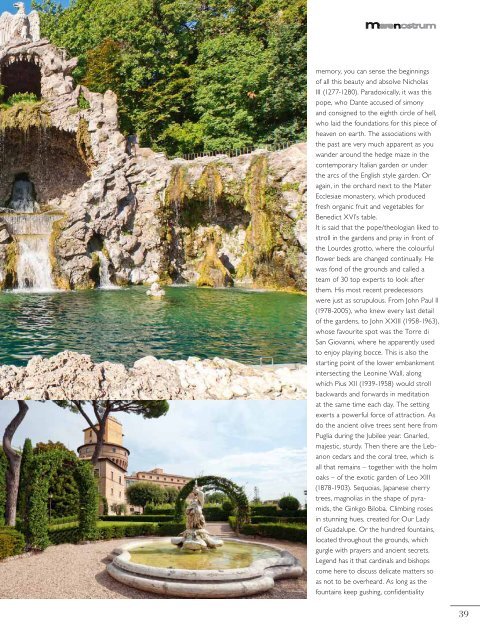umenitsa - Patrasso - Grimaldi Group
umenitsa - Patrasso - Grimaldi Group
umenitsa - Patrasso - Grimaldi Group
You also want an ePaper? Increase the reach of your titles
YUMPU automatically turns print PDFs into web optimized ePapers that Google loves.
marenostrum<br />
memory, you can sense the beginnings<br />
of all this beauty and absolve Nicholas<br />
III (1277-1280). Paradoxically, it was this<br />
pope, who Dante accused of simony<br />
and consigned to the eighth circle of hell,<br />
who laid the foundations for this piece of<br />
heaven on earth. The associations with<br />
the past are very much apparent as you<br />
wander around the hedge maze in the<br />
contemporary Italian garden or under<br />
the arcs of the English style garden. Or<br />
again, in the orchard next to the Mater<br />
Ecclesiae monastery, which produced<br />
fresh organic fruit and vegetables for<br />
Benedict XVI’s table.<br />
It is said that the pope/theologian liked to<br />
stroll in the gardens and pray in front of<br />
the Lourdes grotto, where the colourful<br />
flower beds are changed continually. He<br />
was fond of the grounds and called a<br />
team of 30 top experts to look after<br />
them. His most recent predecessors<br />
were just as scrupulous. From John Paul II<br />
(1978-2005), who knew every last detail<br />
of the gardens, to John XXIII (1958-1963),<br />
whose favourite spot was the Torre di<br />
San Giovanni, where he apparently used<br />
to enjoy playing bocce. This is also the<br />
starting point of the lower embankment<br />
intersecting the Leonine Wall, along<br />
which Pius XII (1939-1958) would stroll<br />
backwards and forwards in meditation<br />
at the same time each day. The setting<br />
exerts a powerful force of attraction. As<br />
do the ancient olive trees sent here from<br />
Puglia during the Jubilee year. Gnarled,<br />
majestic, sturdy. Then there are the Lebanon<br />
cedars and the coral tree, which is<br />
all that remains – together with the holm<br />
oaks – of the exotic garden of Leo XIII<br />
(1878-1903). Sequoias, Japanese cherry<br />
trees, magnolias in the shape of pyramids,<br />
the Ginkgo Biloba. Climbing roses<br />
in stunning hues, created for Our<br />
Lady<br />
of Guadalupe. Or the hundred fountains,<br />
located throughout the grounds, which<br />
gurgle with prayers and ancient secrets.<br />
Legend has it that cardinals and bishops<br />
come here to discuss delicate matters so<br />
as not to be overheard. As long as the<br />
fountains keep gushing, confidentiality<br />
39

















